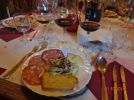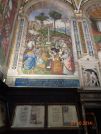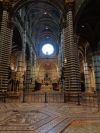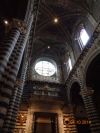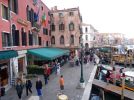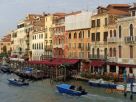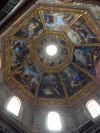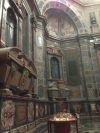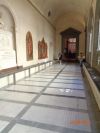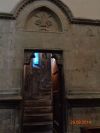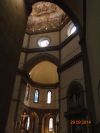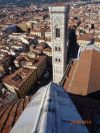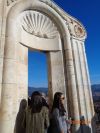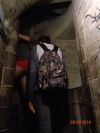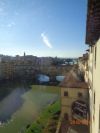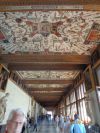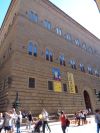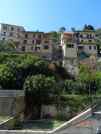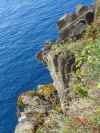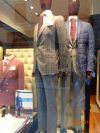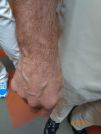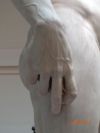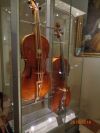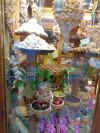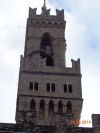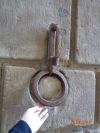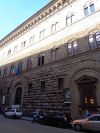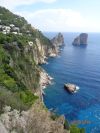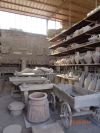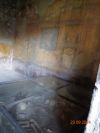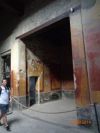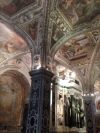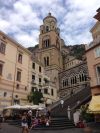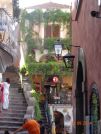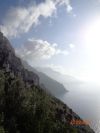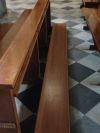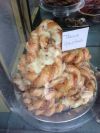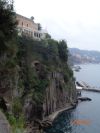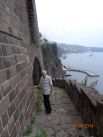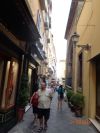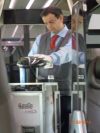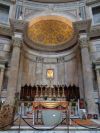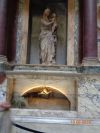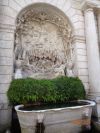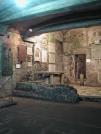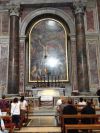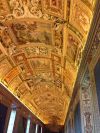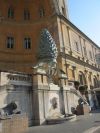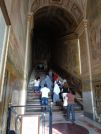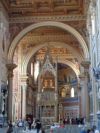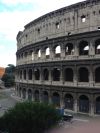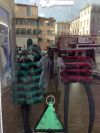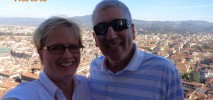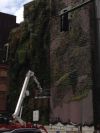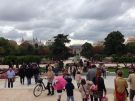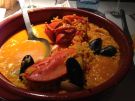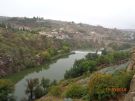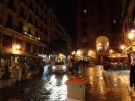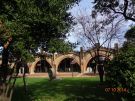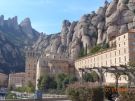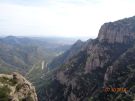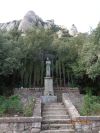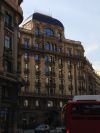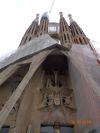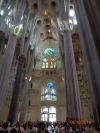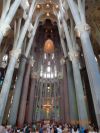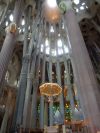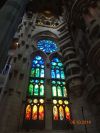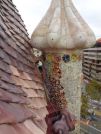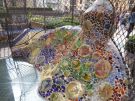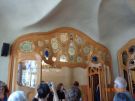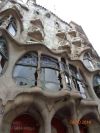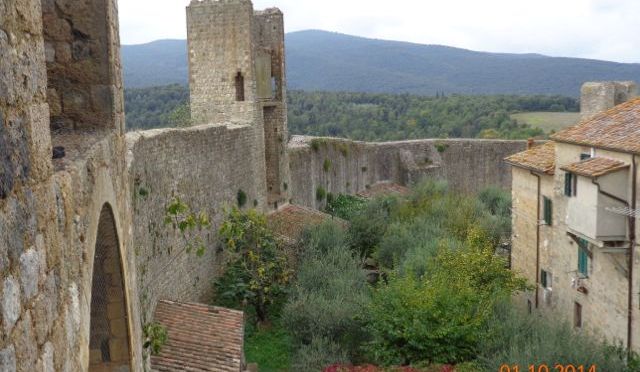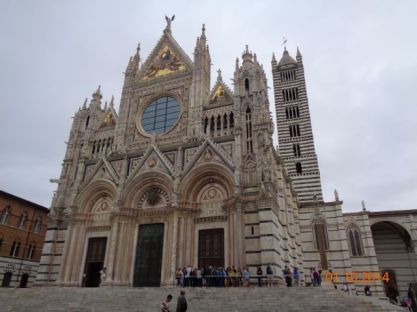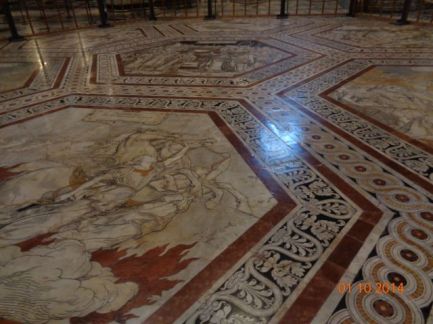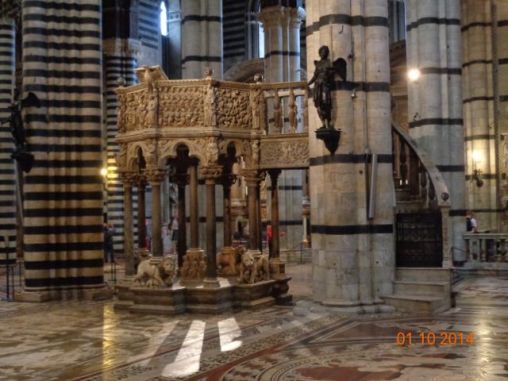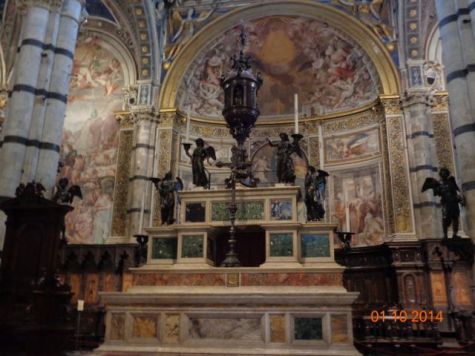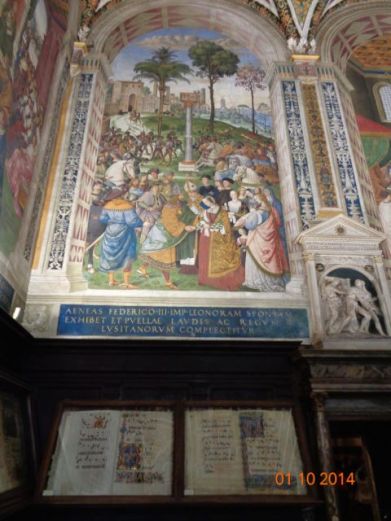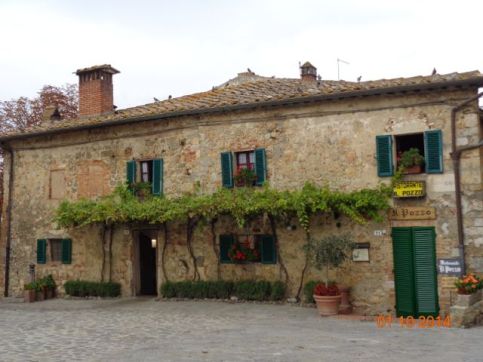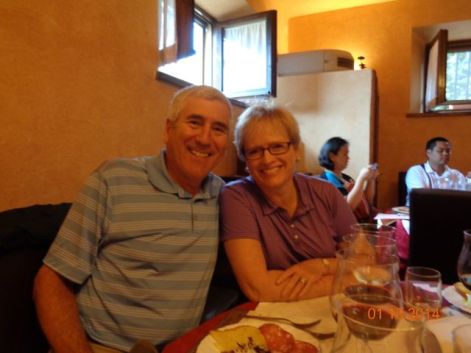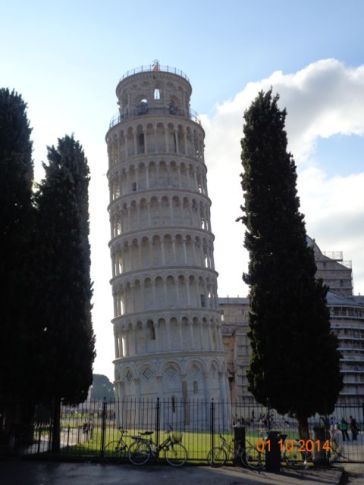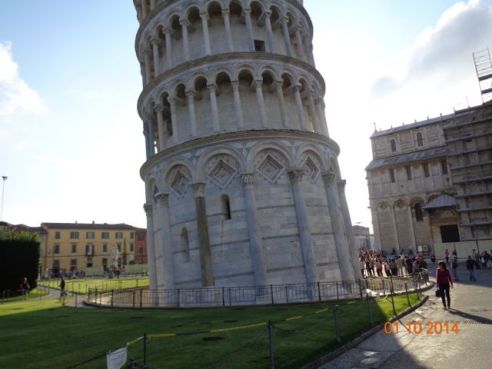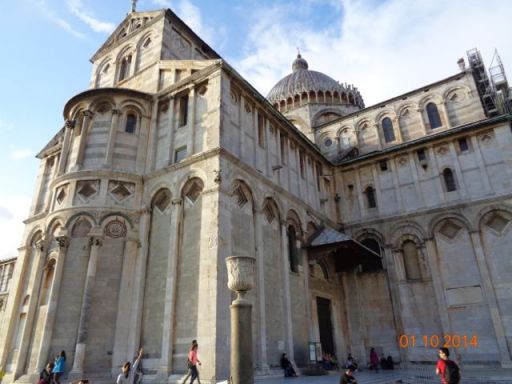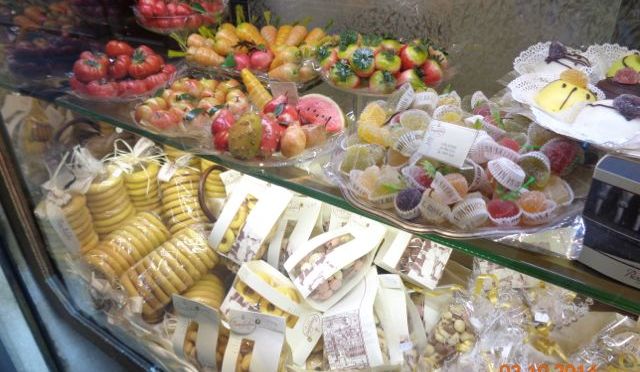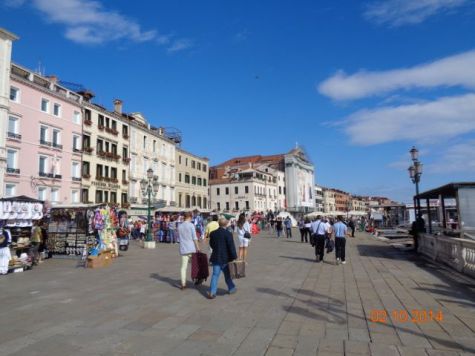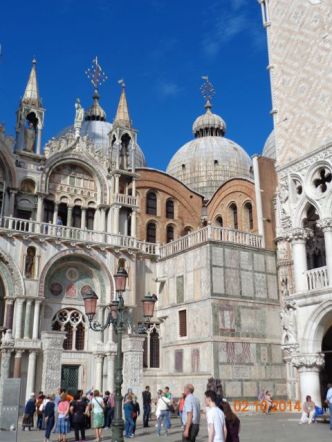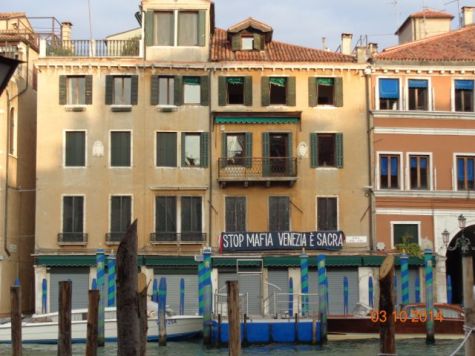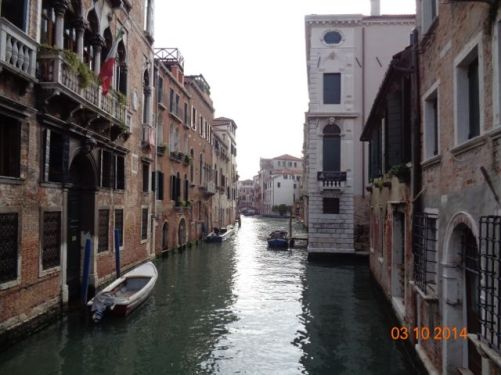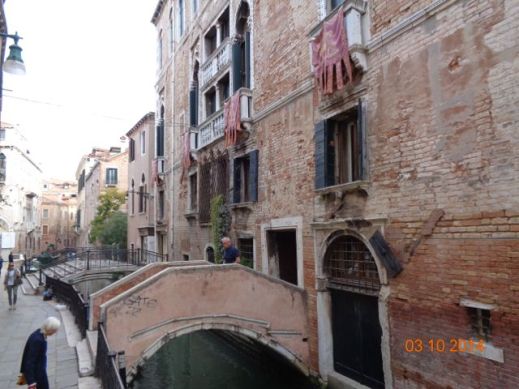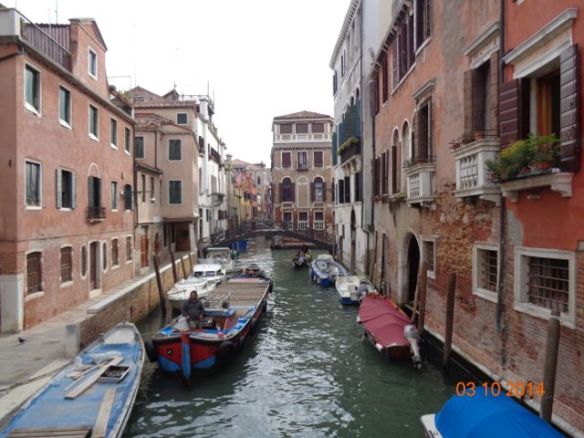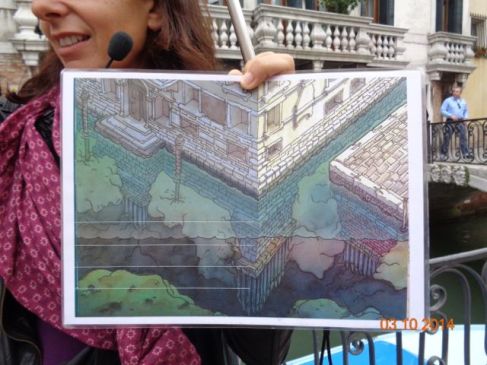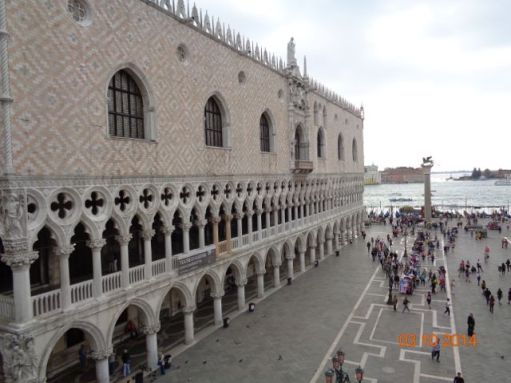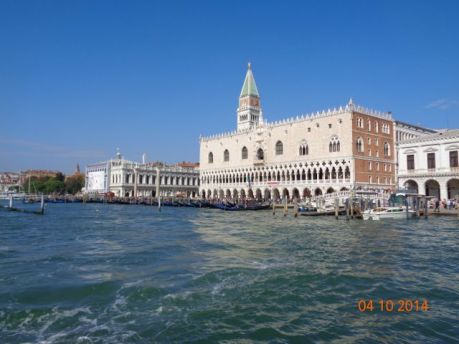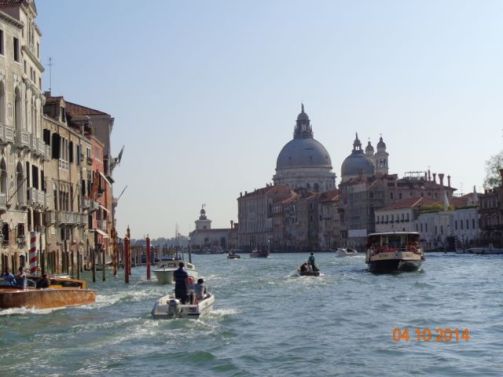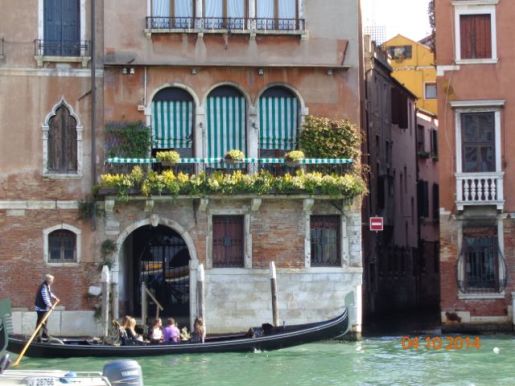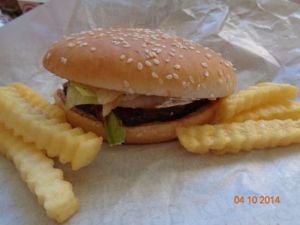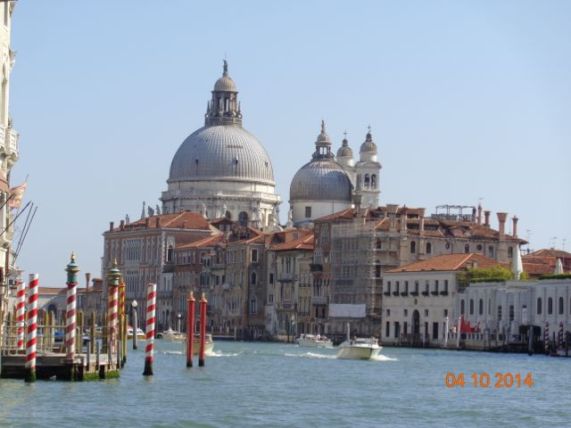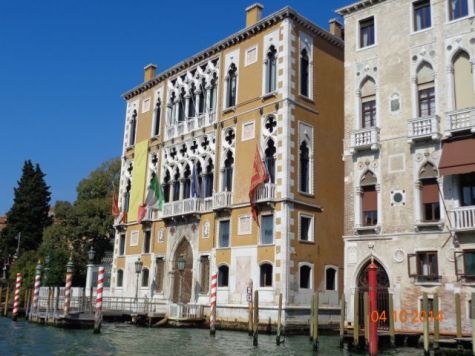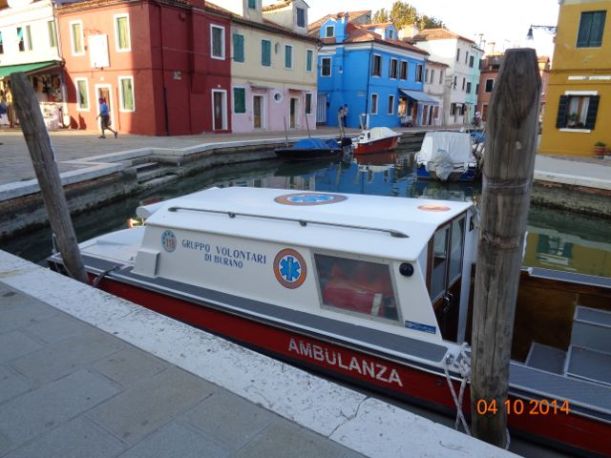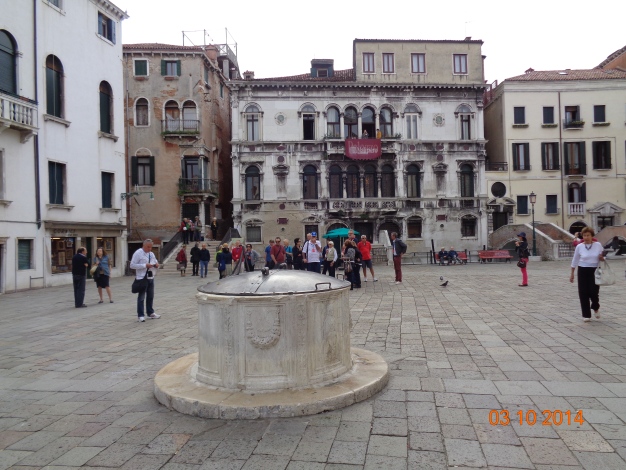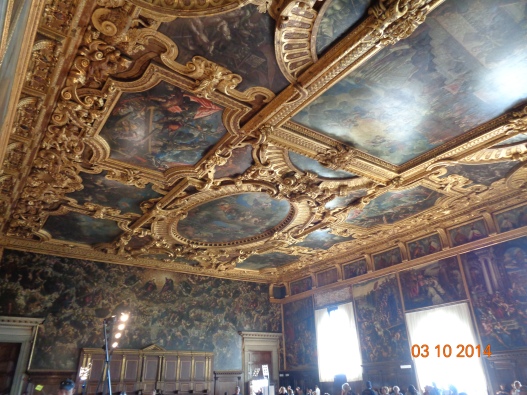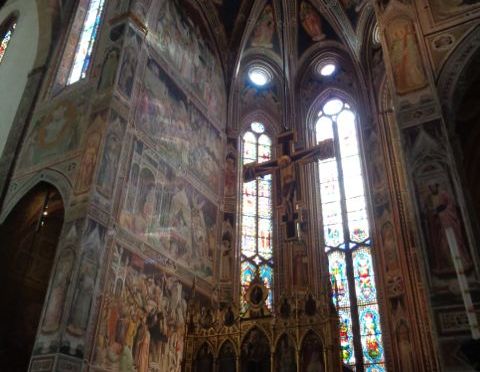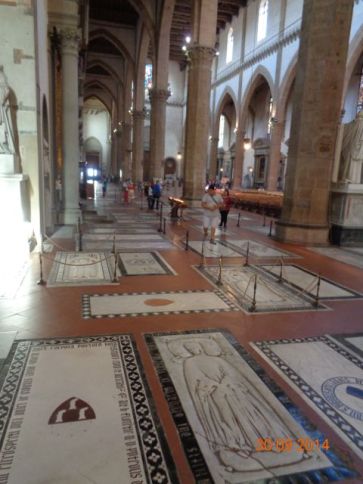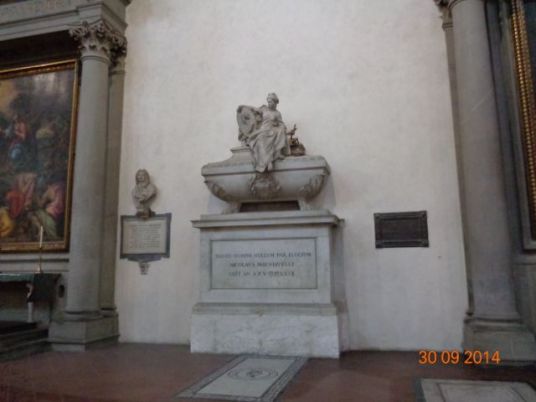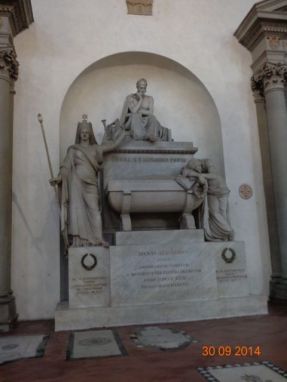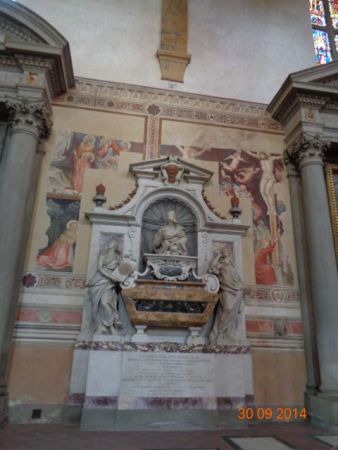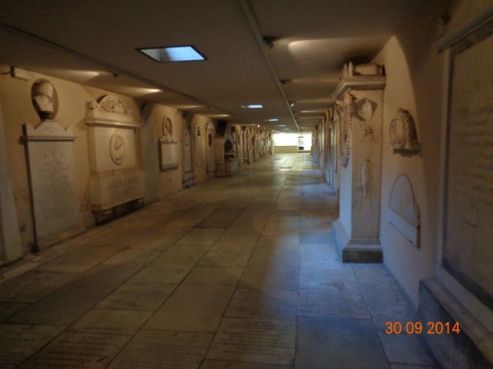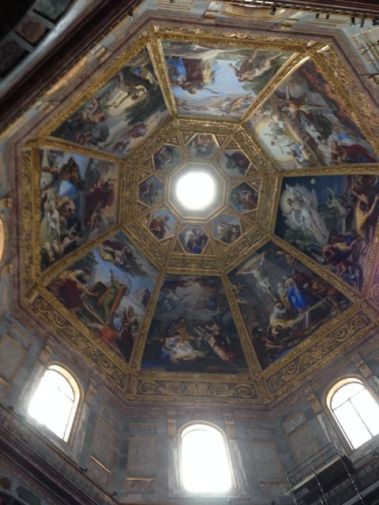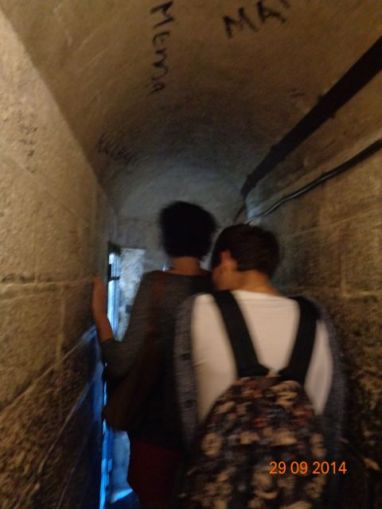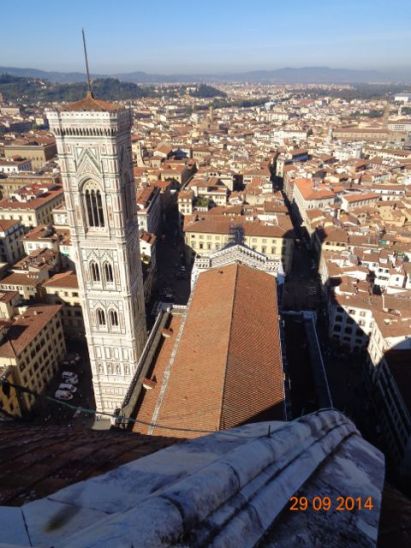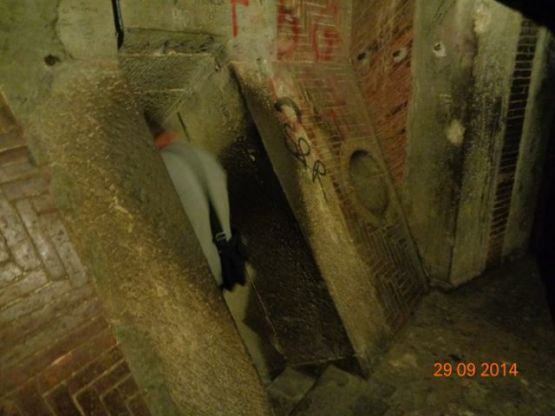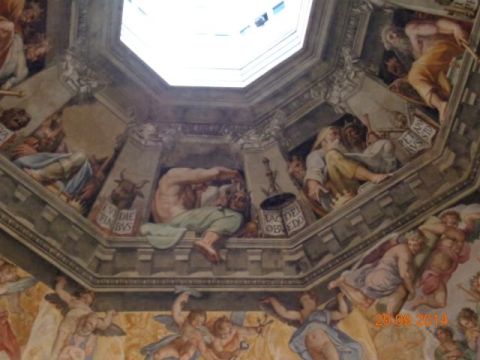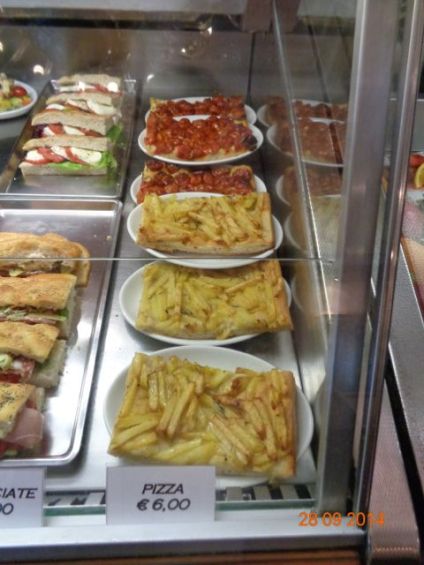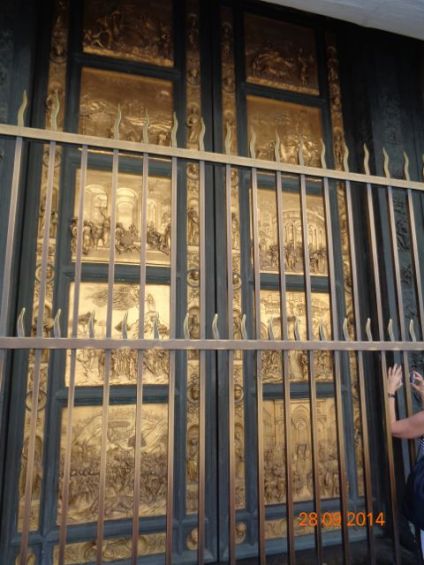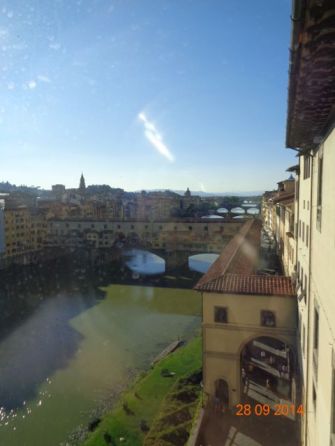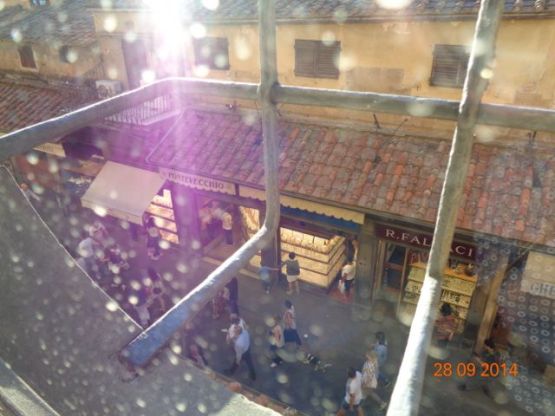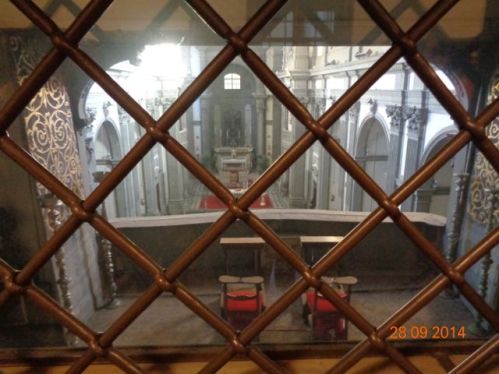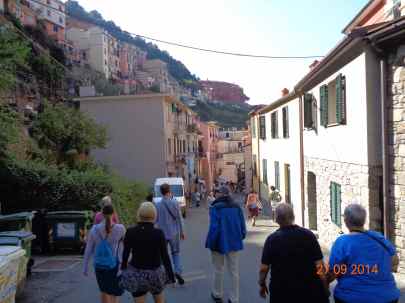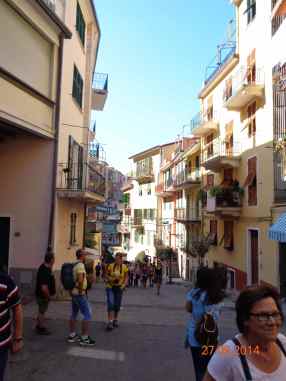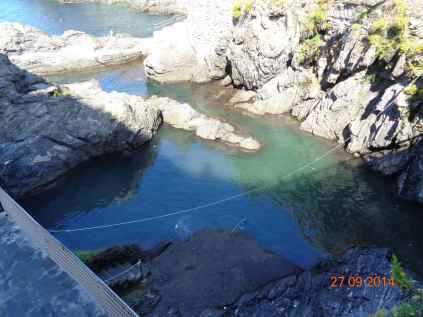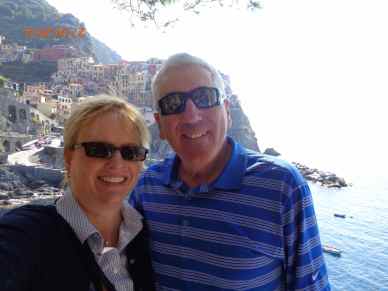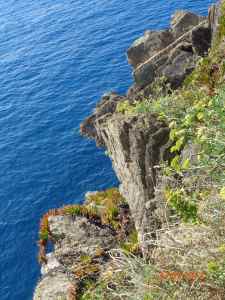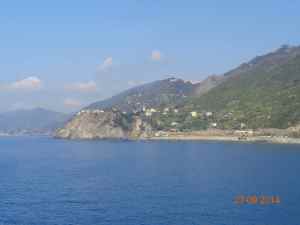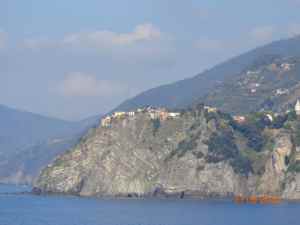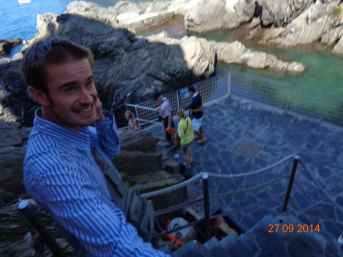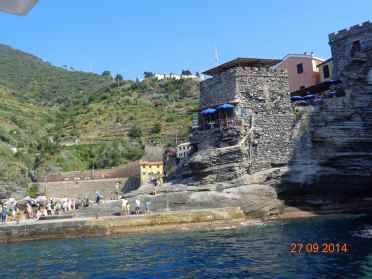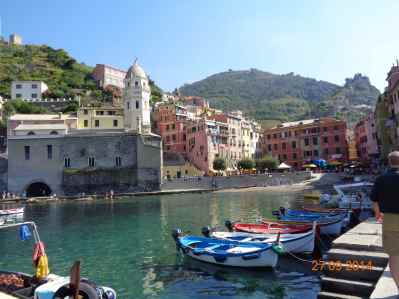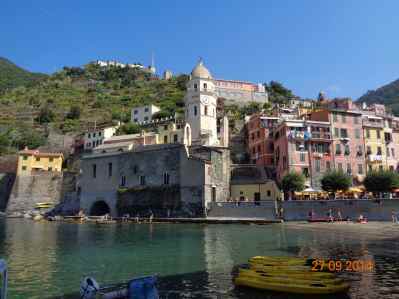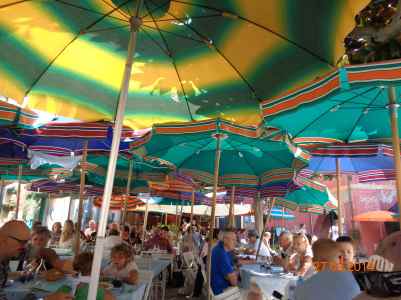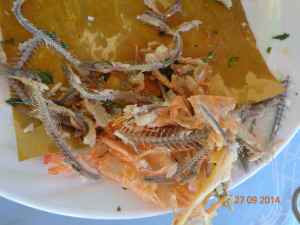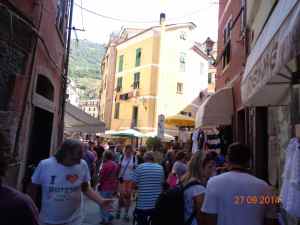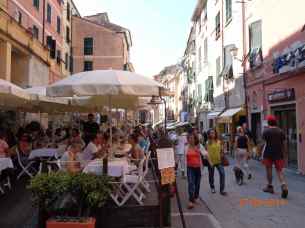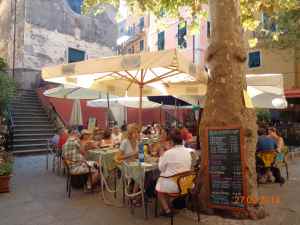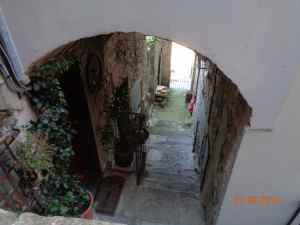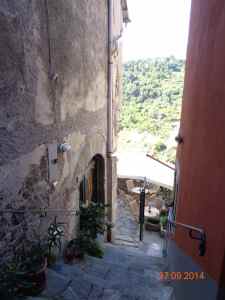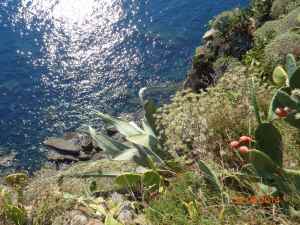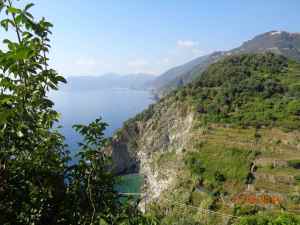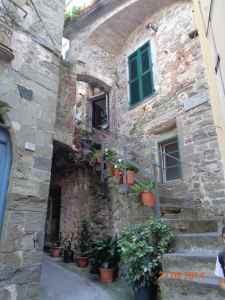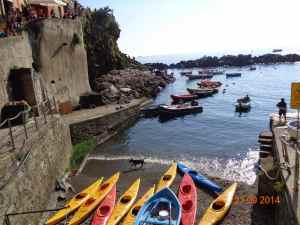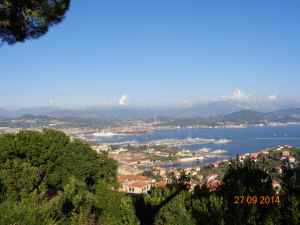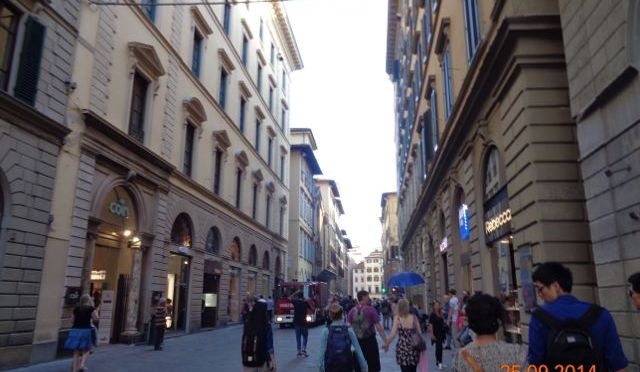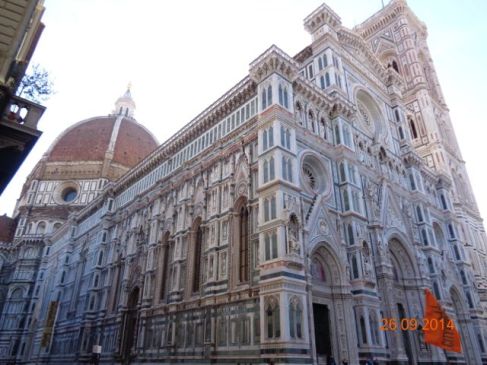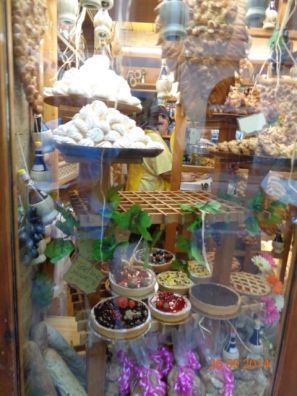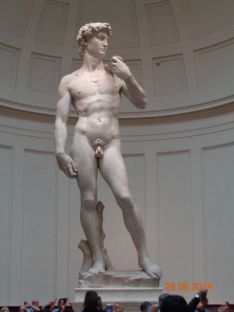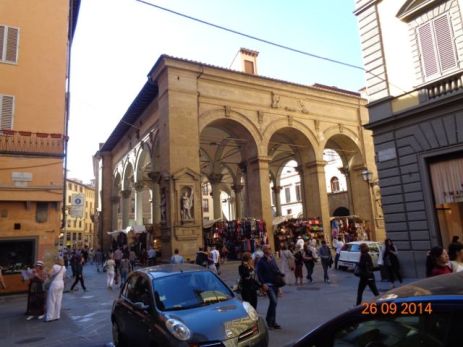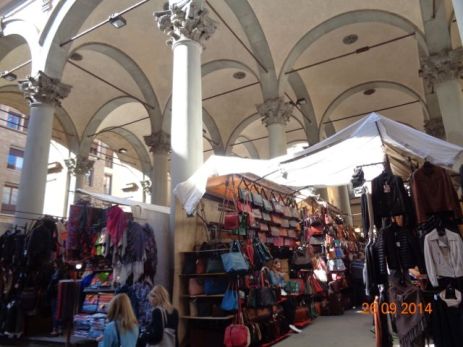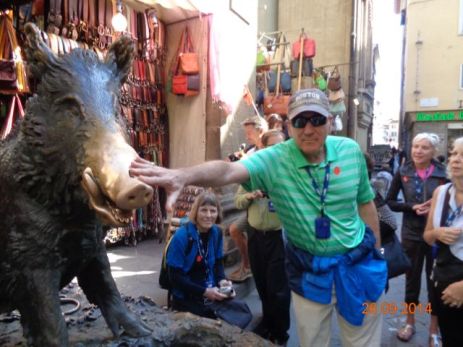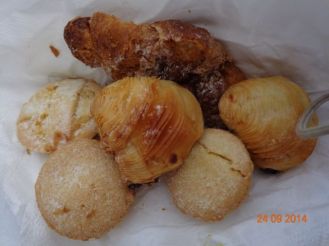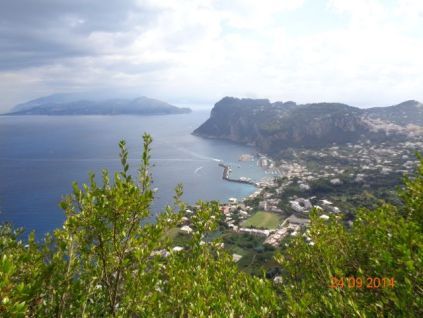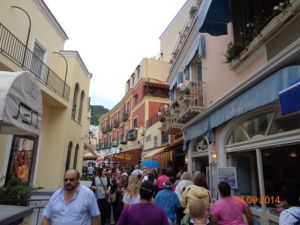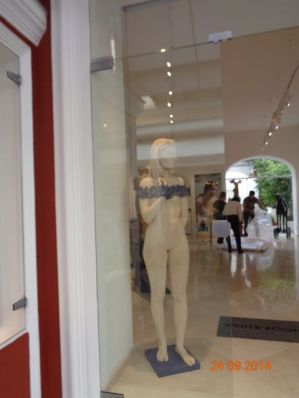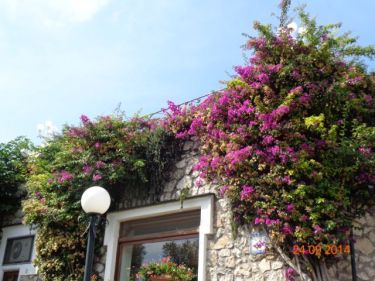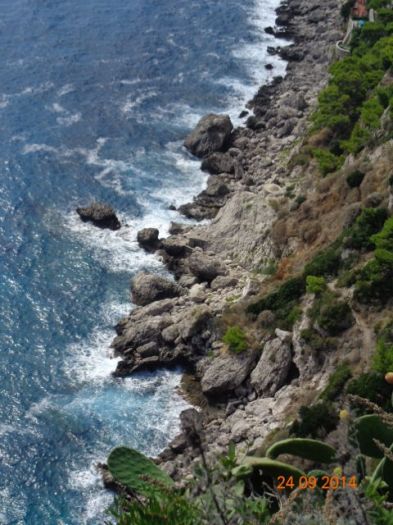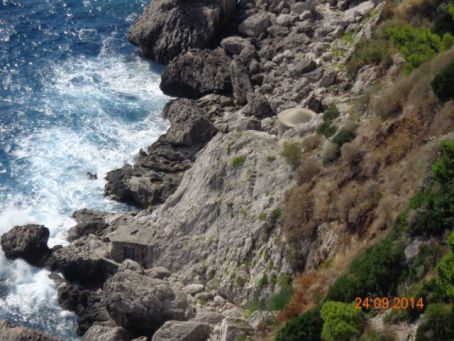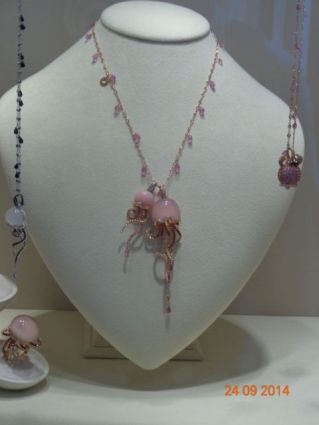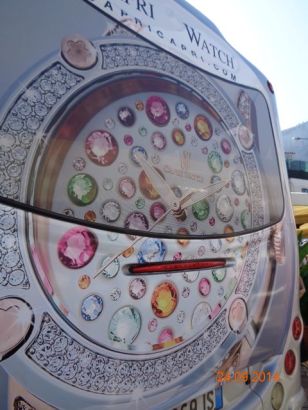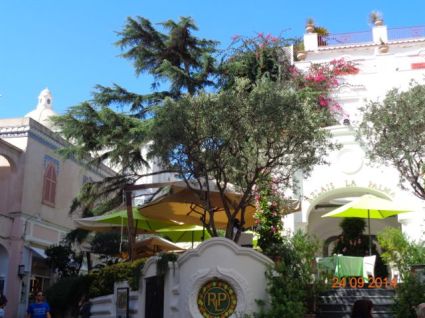Category Archives: Italy
Spain photos
Tuscany
Wow, the dates on this blog have gotten really screwed up! We were actually in Tuscany on October 1st. From Florence, we took a tour of four Tuscan towns and one divine stop for a wine tasting.
Our first stop was Siena. We only had a short time here, so we pretty much confined ourselves to the Cathedral. But it was a really incredible Cathedral.
Street in Siena.
Here’s the outside of the Cathedral. There were little spiky things sticking out all over and when I zoomed in, I realized they were statues of sitting dogs, complete with leashes.
Here’s the inside. It was full of black and white marble.
The floors were spectacular and they told stories.
One of the side altars.
This is where the lector reads the readings. It was beautifully carved.
The main altar.
This was a very pleasant surprise for me. I love illuminated manuscripts so finding a room dedicated to them was a real thrill. To find them in such a beautiful room was pure pleasure. The first pictures one of the many illuminated manuscripts. The next picture is the ceiling in the room. The colors were spectacular. The last picture shows the wall of the room with a couple of the manuscripts on display below. It was a stunning room.

We stopped for a drink on the way out of town and this sign made me smile. The Italians love sparkling water and this is the store owner’s way of saying this is the still water.
Our next stop was Monteriggionni, a very ancient medieval city. It was kind of famous historically and its been in many paintings. It’s also near Voltura, made famous by the Twilight books.
Some of the scenes from this very small town
It’s a walled city and here’s what they look like from the outside.
Our next stop was a wine tasting. Now, those of you who know us know that we rarely drink. This tasting included about 10 different wines. Needless to say, it was a little overwhelming.
Here we are before we had just a little too much to drink. : ) Ironically, after tasting all that wine, what did we buy? We got the truffled olive oil which was TO DIE FOR! Of course, the wine may have influenced our opinion. I’ll let you know when we get home and try it again.
Our next stop was San Gimignano. It’s also a medieval city, but it’s much larger and people actually live there today. It was interesting to stroll around. Luckily, the rain didn’t cause too many problems.
The first picture above is the entrance into the city through the city wall. The second picture is a view of the street.
Here’s the city square and the well.
A view of the Tuscan hillside from the city walls.
Next stop: Pisa! What trip to Tuscany would be complete without a stop in Pisa?
It’s still leaning. Although there was an effort made in the last few years to shore up the ground around it to stop it’s slow topple. To everyone’s surprise, the work actually made it straighten a little!
The tower is actually the bell tower for this church. We only had a short time and decided more food (after all that wine!) was more important than touring the church.
Venice
I really didn’t think I’d like Venice as much as I did. I’m not a water or boat person, but the charm of this city is impossible to resist. It started life as a group of about 118 islands that were close together. As people fled the wars on the mainland (barbarians, Visigoths, Genghis Khan, etc.) each new group settled a new island. The first thing they built was a church and the town square–called a campo which was really a field in the middle of their houses where the livestock hung out and the dead were buried. Eventually, they started building bridges to hook the islands together, and finally, they built so many buildings on the islands, they began to look like buildings rising out of the water, rather than buildings sitting on small islands. So, that’s how the canal system developed; they were just the natural waterways between the little islands. In the last 200 years, many have been filled in and more walkways were created. Today, you can walk from island to island over the more than 400 bridges and on the walkways that surround the city.
I should also note that Venice is very different now than it was even several decades ago. It is very expensive to live here so its population is decreasing. It’s gone from about 200,000 in the middle of the last century to about 58,000 today. Every day 40,000 additional people commute to the city for work. Each year they welcome 25 million visitors. The city is completely dependent on tourism; there is no longer any industry or other business in the city. It’s all tourism. One of the tour guides referred to it as a city-museum, and that about what it is. Some of the large buildings along the Grand Canal are empty and they are only maintained for appearances. It’s kind of sad, really. Even the glass making on Murano and the lace making on Burano are dying art forms.
Okay, enough of that. What exists in Venice is spectacular and shouldn’t be missed. Everyone should come here at least once in their lifetime, it is just so interesting.
We arrived at the train station, which is at the end of a 4 mile long bridge that connects Venice with the mainland. From there, we took a water taxi to our hotel. It required a trip along the entire length of the Grand Canal and it blew me away.
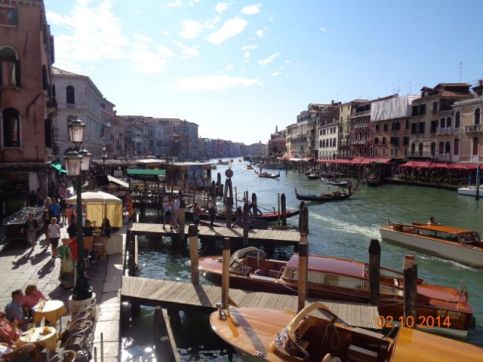
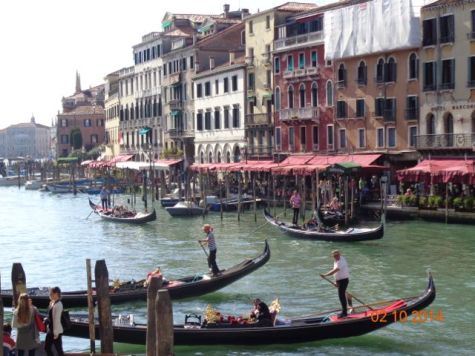
Here area couple of pictures I took of the Grand Canal from the Rialto Bridge. It was just amazing.
This is the view out the front door of our hotel.
This area along the Canal has the widest sidewalks in front. In some places, they’re only a couple feet wide!
Some of the scenes between the hotel and St. Mark’s Square.
And here we go! St. Mark’s Square was only a couple minute walk from the hotel. Our first visit was the afternoon we arrived and it was mobbed with people. There are cruise ships dropping off thousands of people every day and that day, I swear they were all at St. Mark’s!
This is the view of the Doge’s Palace from the bridge in front.
We’re here!
We got up early the first full day to walk to the meeting point for our tour. We discovered St. Mark’s Square is deserted in the morning.
Some of the things we saw along the way. The Grand Canal is the main waterway throughout he city, but it is also riddled with little (and I mean tiny! I don’t know how boats pass each other in some of them!). In between he canals are hamster trail-like walkways. They twist and turn and it is impossible not to get lost. The guide book says there really isn’t an accurate map of Venice that’s economical enough for tourists. Just go with the flow!
Also, I thought the “stop mafia” sign was interesting.
We found our way back to the Grand Canal. The colorful boat in the foreground is a vaporatto–aka: a water bus.
While we were standing here, a boat docked that was loaded with boxes of vegetables. We watched as the guy on the boat literally threw boxes of tomatoes and lettuce to the guy on the dock without losing even one in the water.
One of the side canals. This one is pretty good sized.
Here are more of the smaller canals. They vary greatly in size because they were as big as the space between islands.
This building was finished in the 14th or 15th century and today it is the hospital.
With all the parked boats, I don’t know how another one can pass through.
Here’s a picture showing how the buildings were made. Wood pilings were driven into the bedrock very close together. In the absence of oxygen, they didn’t rot. Instead, they petrified and became a very strong foundation. On top of the pilings are various waterproof layers and the building sits on top of all that. I was surprised that they don’t need to be replaced regularly. They are pretty permanent.
The covered bridge in the distance is the Bridge of Sighs, the bridge that lead from the Doge’s Palace (where a prisoner was sentenced) to the prison. The bridge gave the condemned their last view of the Venice, thus the nickname, The Bridge of Sighs.
St. Mark’s Square is one of the lowest spots in Venice so it often floods. Of course, the tides rise and fall daily, but they sometimes overtake the city. As many as 50 times a year Venice floods. When this happens, they put these low tables down to make raised walkways for people to pass. The locals often just wear knee (and sometimes hip) boots when it floods. The floods usually happen in winter.
We climbed to the balcony of the church to get a good view of St. Mark’s Square. The crowds were much better today.
These are all views of St. Mark’s Square and the Doge’s Palace. I didn’t realize that Venice is one of the longest lasting Republics in history. For hundreds of years (much longer than the US!) Venice was governed by a “congress” of about 2000 noblemen who elected the Doge (i.e. president) from among them. They had incredible checks and balances in place at all levels of the government and it seems to have worked really well for them.
This is the Rialto Bridge, one of the four bridges that cross the Grand Canal. Did I mention that nothing with wheels is allowed in Venice? The only exceptions are dolly’s (to move boxes) and a few kid’s toys, roller skates.
Bob : )
Here you can see how narrow some of the side canals can be. As I said, I don’t know how boats, even skinny ones like the gondolas, could pass each other in such a narrow canal.
No judging! After weeks of pizza and pasta, a whopper from Burger King sounded like the perfect lunch. We got a king-sized meal and split it. It was delicious. Although, the Coke had no ice. Not sure what that was about. : )
I do have to tell you about the cheeky pigeon. We sat in the courtyard outside and we were surrounded by college-aged kids from all over the world. At one point, a pigeon jumped onto the table next to me and the guy there shoo’ed it away very aggressively. I think he startled it because it flew straight sideways into an Asian girl who shrieked and caused quite a seen. I was still chuckling when the pigeon jumped onto our table and grabbed a fry. It just stood there looking at me with that fry in its beak. I didn’t want it to assault the poor Asian girl again, so I shoo’ed it gently but it just stood there mocking me. So I swatted at it thinking it would jump out of the way. It didn’t! Instead, I smacked it in the chest and pushed it off the table and onto the floor! I don’t think it cared at all, it was busy eating my fry.
More of the views from the Grand Canal. I think this is one of my favorite pictures.
More of the Grand Canal
We also took a tour of the islands of Murano and Burano. Here’s Bob on the boat out to the islands.
The Murano glass is really beautiful. In the past, the different techniques were passed from father to son, but they are slowly dying out. Only a fraction of the glass workshops from the past are still open.
This is Burano which is known for its lace. Again, the art of making lace is dying out because it can be made by machine so much faster. It takes forever to make it by hand and I was staggered at the prices. A small piece, about 8 inches in diameter, that was suitable for framing, took 7 people 7 months to finish. They were charging 800 Euro which is roughly $1000.
This reminded me of growing up in South Dakota. It’s the volunteer ambulance, only it’s a boat.
This isn’t a great picture, but it shows something I found fascinating. When there aren’t enough spots for all the boats to dock, the boats line up and hook themselves together. To get on and off the furthest boat, you have to walk through all of them. It was all new to me.
I can’t believe I didn’t take more pictures of the little alleys. This is a large one. Some of them require you to turn sideways when someone passes going the opposite direction.
This is one of the campos — or little fields. There’s one on each island, or at least there used to be. Some have been replaced with buildings. There’s a cistern under each one that caught rain water and this is the well where people could draw fresh water out.
Here we are on the observation deck of the church on St. Mark’s Square. It was a spectacular church, but no pictures were allowed. The most amazing thing there were the life sized (or maybe slightly larger than life sized) bronze statues of four horses. Scholars debate their age, some say 200 B.C, some say 200 A.D. In either case, the statues are about 2000 years old. They were incredibly beautiful and the details were perfect.
This is inside the Doge’s Palace. It’s a very large building that was the seat of the government, as well as the home of the doge. When a new doge was elected, he and his family were obligated to live here, sort of like the President and the White House. It had some breath-taking rooms.
In some cases, the frames are more incredible than the paintings. Since this is Venice, frescoes deteriorated within a few years. So, they either had to make everything out of mosaics, or they had to paint it on canvas. In these pictures, all the paintings are done with oils on canvas.
Now this is an interesting room. It’s where the 2000 noblemen met and it’s the largest room in the world that doesn’t have columns to support it. It’s about the size of half a standard soccer field and it was built in the 1500s. Also, the painting on the far wall is the largest canvas painting in the world. It’s about 25 meters wide.
Forget the hotel, this is the Museum California. At least they warned you before you got stuck inside!
Finally, I took many videos going up and down the Grand Canal and I put one of them on Youtube. It’s only a minute or so and it ends with my favorite view on the Canal. Enjoy!
https://www.youtube.com/watch?v=hK1ohreMF84&feature=youtu.be
Santa Croce and the Medici Chapels

Wow, what a day! Today we spent the morning with Michelangelo, Dante, Machiavelli, and Galileo, just to name a few. Really, truly. We found all their tombs inside Santa Croce, another incredibly beautiful church in Florence.
After a break for lunch we also explored the Medici Chapels which were covered entirely in semi-precious materials such as jade, quartz, lapis, etc. The workmanship was spectacular. As always, pictures are the way to go!
Here’s the outside of Santa Croce. It’s very similar to the Duomo, but not quite as elaborate. However, unlike the Duomo, this church is breathtaking on the inside
.
This is a view from the back. It’s quite large and contains many important works of art. But the thing that impressed me the most is the fact it was literally paved with grave markers. The entire church is an enormous graveyard.
When we were on the Amalfi Coast, we learned that Italians bury their dead within 24 hours and they don’t embalm them. A couple years later, the body is exhumed and the bones are put in the family vault where generations of the same family can be found. I think this church is the final resting place of the bones.
Here’s the main altar. It was hard to get a good picture because the sun was shining brightly through the stained glass. 
Just to the side of the altar were 10 alcoves, 5 on each side. Each one was completely different. You can see Bob here, surrounded by grave markers.
More of the grave markers.
And here we have Machiavelli’s final resting place.
And here’s Dante — the man who wrote the Divine Comedy.
And here’s Michelangelo. He lived to be 89 years old, an unheard of age at the time he lived. He died in Rome and wanted to be buried there, but his body was stolen in the night by several Florentines and he was buried here before anyone in Rome (namely, the Pope) could object.
This is Galileo Galilei. I was surprised to find him here because I thought he was excommunicated for his scientific findings.
More of the grave markers. They were literally everywhere. Take a look at the floors. Every tile is marked with who’s lying beneath.
I just liked this poor bored angel. Although, her long-suffering lion also deserves some sympathy.
Next on our tour was the Pitti Palace, lunch, and San Lorenzos. But the real show stopper was the Medici Chapels. They were built in honor of the first several Medici’s who ruled Florence back in the day. It was also meant to be the place where all the Medici’s would be buried. To build the chapels, the Medici family sponsored a new kind of art. They knew frescoes and paintings would eventually fade, so they had the entire inside of the chapels, including all the “paintings” made out of precious and semi-precious stone. It was stunning. And HUGE! The main chapel is absolutely enormous.
Here you can see the scale of this chapel compared to the people on the ground. Enormous doesn’t begin to describe it. Above what you can see here is another section of wall just as big, then there’s a beautifully done dome. Everything you see is covered in perfectly fitting stone.
It was impossible to get a photo to do this room justice. Also, half of it was covered by scaffolding because of restoration work. Apparently, all that precious stone is held in place with nails and a large panel fell out of the ceiling in 1999. Since then, renovations have been on-going.
Just in case it wasn’t clear before, the big tomb-like things are . . . tombs. They hold the first two or three Medici’s that ruled Florence. They were the good rulers. The next several (the ones who built this chapel) were real tyrants and hated by the people. Luckily, they got better after that. : )
Each of these is close to 2 feet on its long side. So they aren’t very big, but the colors and detail are stunning. They are made entire out of precisely cut gem stones. There is no grout, they stones fit perfectly together.
Here’s some close ups of the details. Every color is a different precious or semi-precious stone that’s been cut to fit precisely with the stones around it. If you ran your hand over the pattern, it is completely smooth. (Except for the last picture where the stones were purposely three dimensional.) The workmanship is exquisite. The benefit is the ornamentation will never fade and the chapel will never lose its splendor.
We saw so many other awesome things today, including more at Santa Croce and the Medici Chapels, but it’s just too much to share. Plan a trip to Florence! I’m sure you won’t regret it.
Top of the Duomo
Wow, what a trip! Not only does the top of the Duomo offer an incredible view of Florence, it is also an architectural miracle and we were allowed to climb all over it!
The only way to describe this adventure is with pictures. But, for perspective, here’s what we did. Inside the church is a little door that leads to a staircase that climbs straight up. Up 5 steps, turn, up 3 steps, turn, up 5 steps, turn . . . FOREVER! It’s about 460 steps to the top; I think that’s the equivalent to a 20 story building. At some point, the staircase turned into a spiral and when we reached the dome, it got pretty creative. Keep in mind the stairs were built in about the 1400s when the church was built.
So, here we go!
Here’s the outside of the church. It has a long part in front and the dome in the back. Off to the right side in this picture is the tower, which is not attached to the church. It’s hard to tell that since it is decorated exactly like the church on the outside.
By the way, that little, tiny part sticking up out of the dome — that’s our destination. It’s called the lantern.
You enter the church through a side door and go through this door. It’s the one that gives you access to the stairs.
The stairs are narrow and the ceiling is sometimes low. They highly recommend you skip this if you’re claustrophobic or have a fear of heights. Very good advice!
The first stop is the balcony, just below the large circular windows. It gives you a much better view of the ceiling frescoes. Here area a couple of pictures. The balcony goes all the way around the dome, but only half of it was open. You had to go around to the other side to pick up the stairs that go up the side of the dome.
To give you an idea, if you look back at the picture of the outside of the church (the one above) you can see one of the round windows at the base of the dome. We were on a balcony just below those windows in the pictures above.
Ha, ha! I little late for this sign : ) That’s 500 years of graffiti!
Thankfully, we had to stop often on the stairs, especially toward the top. They pack quite a few people in, so it’s crowded. Also, at the top, the stairs are shared by those going up and those going down. Unfortunately, the stairs aren’t big enough to accommodate everyone so you have to find a side niche to stand in while the traffic going the other way passes. It was quite a shuffle!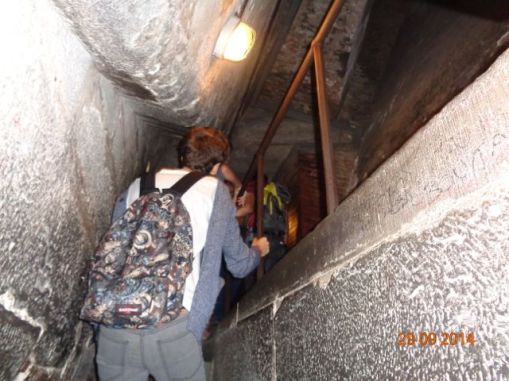
As you can see, the stairs get tiny in places. They’re also uneven, steep and they aren’t uniform. Of course, the lighting is dim, so watch your step! In the second picture, the one with the person in the red shorts, these stairs take you between the inner dome and the outer dome. You can see how the roof and the floor both curve in the picture.
While waiting for some downward-bound traffic to pass, we got shuttled into a little side area where I saw this room for the people who work up here. It was tiny. And God knows where that odd door on the right goes!
Finally! We made it! We are standing at the base of the lantern, which is the lynchpin that keeps the dome from collapsing. In actuality, there are two domes. The inside one pushes out against the outside dome which keeps it in place. As I said, it’s an architectural miracle that I don’t completely understand.
Here you can see the rest of the church and the tower beside it. The rib running down the dome is one of many and they are the weight-bearing part of the dome.
Okay, after cooling off, catching our breath, and soaking up the sights, it was time to head back down.
After climbing down the ladder, we ended up here, in a little room between the inside and outside domes. We had to go through the tiny door.
Then down this staircase. We had to climb down one exactly like it and luckily we don’t have to share it with those coming up. This is the part that follows the curve of the inner dome, so it was quite steep.
On the way down, we got to stop at the upper balcony, the one above the round windows. (The other balcony was below the round windows.) From here, the frescoes were very close. The figures were huge, so much bigger than they look from the ground. You don’t think about how big all the figures have to be painted when you’re standing on the ground.
Here’s a picture from the ground that shows where we were. See the balconies just below and above the round windows? We were there!
I tried to video some of the stairs to give you an idea of what it was like. See what you think!
https://www.youtube.com/watch?v=KVjLiruupfo&feature=youtu.be
Uffizi Museum and the Vasari Corridor
Since we didn’t have a tour planned for this morning, we thought we’d go to Mass. Unfortunately, our usual luck followed us and it was a big no-go. Those of you who’ve followed this blog in the past know our efforts to go to Mass have become sort of a joke. We just can’t seem to pull it all together. We had a chat with the concierge last night to find an English Mass and he was happy to look them up for us. He found two . . . but both were on Saturday and we’d already missed them. There were two German Masses today, but no English. Maybe the Germans are more faithful? I just can’t believe there’s isn’t one English Mass somewhere in the city on Sunday given how many tourists are here. Oh, well. Sorry, Mom!
Even though it was Sunday, Florence was open for business. In fact, there was some kind of run this morning so the streets were full of contestants and their families enjoying the beautiful weather. We spent several hours wandering all the streets, getting lost, and finding the Basilica of Saint Mary of the Flowers again. It is so beautiful. In front of it is the Baptistry (which is completely wrapped in scaffolding and plastic because it’s being cleaned.) Luckily, the very famous bronze doors, completed in the 1400s, are still there. The picture above is a close up of a couple of the panels. They are stunningly beautiful. When Michelangelo saw them, he declared them perfect and that they must be the doors to paradise.
Speaking of Michelangelo, remember the other day when I was telling you about the medieval building that sort of set the standard for buildings in the future?
Yup, that one. Well, first I have to say the benches built into the building all the way around are a GOD SEND! Thank you ancient architect, you were very thoughtful. What I really wanted to tell you about it is it was originally the palace built by the Medici family when they first came to power in Florence. They lived here when they recognized the genius of Michelangelo when he was only 12. In fact, they brought him to live with them in this building. So, this is the place where Michelangelo grew up.
After about 100 years in this palace, the Medici family sold it to another wealthy family and moved into the Palazzo Vecchio. This is the place where the Statue of David stood for many years and it was also the seat of the government. So, the Medici family lived in the same building where they worked.
Apparently, it got old after awhile and the mistress of the house coveted another house just across the Arno River. It had a garden and she wanted to enforce some private family time on her husband so he wouldn’t always be working. She eventually got her way and the family moved to the Palazzo Pitti.
The problem was the guy in charge had to walk several blocks from his house to his office and it wasn’t very safe. He always needed an armed escort and he had to cross the Ponte Vecchio which caused traffic problems.
The solution? He asked the architect Vasari to design a private corridor from his house to his office. By then, the office was on the top floor of the Palazzo Vecchio, so the corridor begins on the third floor, crosses a bridge to the Ufizi (which was an office building at the time), crosses to the Ponte Vecchio where it was placed on top of the small businesses that line that bridge, it continues over the roofs of several buildings and crosses through a church before it arrives at the Palazzo Pitti. It was built in only 5 months and over the years, the Medici family lined the walls with paintings, a practice that continues today. You can read more about the corridor here.
http://en.wikipedia.org/wiki/Vasari_Corridor
In short, it permitted the Medici family and their very close friends to travel from home to office in complete privacy. It is said they even sometimes made the trip in their jammies : ) I have some pictures below. It’s closed to the public, but we were able to walk the corridor with the tour we took.
As for the Uffizi, I didn’t take too many pictures; it was VERY crowded. If you want to see the works of art in the Uffizi, they’ve been kind enough to put most of them online. I think this link is a good place to start if you’re curious.
http://www.uffizi.com/virtual-tour-uffizi-gallery.asp
So, now for the pictures!
Some of the little places to eat in Florence are quite charming. Here, we have what appears to be a French Fry Pizza. It’s not even close to the weirdest pizza I’ve seen. I think the tuna pizza, the pumpkin flower pizza (yes, that’s flower, not flour!) and the sliced hard-boiled egg pizza were a little weirder.
In the second picture, you can pick up gelato or pizza and then head upstairs to eat it. All very cozy.
Here are the famous Baptistry doors. They are truly spectacular. You can learn more here:
http://en.wikipedia.org/wiki/Florence_Baptistery#Baptistery_doors
Okay, so we have to start at the beginning with the Palazzo Vecchio. Remember the building with the scary staircase in the tower? Same place. Here’s a picture.
The picture below is what the front looks like. See that building right next door? That’s the Uffizi. Uffizi means “office” and it houses many government offices, both then and now. The museum is on the third floor. If you look down the alley between the two buildings, there is an enclosed walkway/bridge between the third floors. That is the beginning (or end?) of the Vasari Corridor.
Here’s what the main hallway in the Uffizi Museum looks like. The second picture is a close-up of what the top of the walls and the ceiling looks like. Most of the art is in the rooms that line this hall.
This is the view out the window of the Uffizi. See the yellow building with the narrow tiled roof? That is the Vasari Corridor leaving the Uffizi, turning toward the Ponte Vecchio (the bridge) and you can see where it crosses the bridge on top of the little businesses that line that bridge.
Michelangelo’s masterpiece in the Ufizi. Our tour guide when on, and on, and ON about this painting but did he ever tell us its name? I don’t know, I was zoning out. : ( Seriously, it was incredible to look at it. The colors popped out and it is interesting to note that Michelangelo designed the frame, too, and it is meant to be part of the interpretation of the painting. It’s hard to tell, but it’s probably between 4 and 5 feet in diameter.
Here’s an interesting lady. She’s the very last Medici. The family died out in 1743. It was her Will that helped to make Florence the bastion of art that it is today. She left the entire Medici collection to the City of Florence on the condition that none of it ever leave. In fact, the Uffizi Museum was started a short time later to house some of the masterpieces.
A view down one segment of the Corridor.
A view from one of the many windows along the Corridor.
Here’s a view of the shops on the Ponte Vecchio from the Corridor.
Here’s the church as seen from the Corridor. This part reminded me a little of the Disneyland rides that used to drive through the gift shop as part of the ride. It was a little weird.
The Corridor ended at Palazzo Pitti where I found this in the garden. I felt a little sorry for the turtle. : )
This is another section of the Corridor we saw from the ground when we were walking back to our hotel.
Along the way we also ran across this interesting art. It’s hard to see because it’s so big, but there are “people” zip lining from one building to another and there are others climbing the building. Still others were scattered around on the ground that you could take pictures with. I have no idea what it’s called, why it’s here, nothing. It was just really cool.
Cinque Terre

Wow, what an experience. The Cinque Terre, pronounced Chinkwa Tear (like tear paper, not cry a tear), means “five lands.” It consists of five tiny medieval villages that date back to about the 1200’s. Before 1950, the only way to get to them was by boat. Each one was (and still is) linked together by cliff-side paths that are popular with hikers today.
In the 1980’s, these tiny fishing villages were discovered by tourists and their popularity exploded. To protect them and maintain their old world charm, they were included under UNESCO’s umbrella. Today, they exist much as they did in the middle ages.
Between the five villages, there are about 5000 inhabitants. In the smallest, there are only 250 people. They are all built vertically on the cliff face so they were a challenge. What goes down must go up! Only one of the villages didn’t have a “beach.” I use that term loosely and you’ll see why in the pictures. That village was built on the top of a cliff and has shear drops to the sea. I should also mention that the water here is a brilliant blue color. It was a little hazy, so not all the pictures capture the true color, but a few do, thankfully!
So, let’s get to it.
The drive to the coast from Florence was about 2 hours so we stopped at a rest area. It was just like a rest stop in the US except I had to laugh at the scrum around the espresso bar. This spot was more popular than the bathrooms!
This is a good view of the terracing that is all over the hilly areas of Italy, especially the Amalfi Coast, Capri, and the Cinque Terre.
We went to 4 of the 5 Cinque Terre villages. I’m not even going to try and keep them straight, but I’m pretty sure this is Manarola. While they were all the same in the sense that they are very old villages built into cliffs, they are also very different.
They are still fishing villages, but they’re also famous for their wine. Grape vines were everywhere and they’re in the midst of harvesting now
Here are a couple shots of what the main streets look like. It’s hard to appreciate how steep they are from the photos. As you can see, they are full of tourists and there were many Italians visiting since it was a Saturday.
This is a little square in the midst of the village. Up on the hillside, you can see the permanent nativity they have on display. The second picture is a close-up. At night, it is always lit up.
More of the streets. I thought it was interesting that they drag their boats up the street and store them outside their doors.

Here is a view of the “beach” at the foot of the village. There really isn’t any beach to speak of, but lots of rocky spots.
But if you look closely, there are people all over the rocks soaking up the sun. In the top picture here, there’s a handrail to assist swimmers. In the second picture, you can see the walkway along the cliff. It leads all the way to the next village (or it did before a landslide a couple years ago). We walked along the walkway all the way to the point and that’s where the next several photos came from.

Here are some views of the village from that path.
In this picture, you can see the color of the water. It was brilliant blue.
From the point, you could see the village on your left, but the top pictures are the view to the right. One is a wide shot, the other zoomed in. Its the village of Corniglia, the only one of the five villages that doesn’t have a beach–its the one built on top of the cliff.
Lorenzo, our tour guide, taking us down to the boat dock for a ride to our next stop. Since Corniglia doesn’t have a dock, we had to skip it and go to the next village down the line. Once we got in the car again, we doubled back to Corniglia. Pictures to come!
Another picture that begins to accurately show the color of the sea.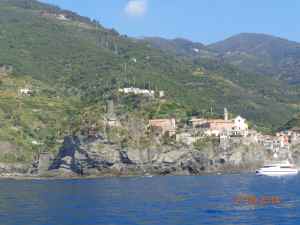
Our next stop, the village of Vernazzo. You can see all the people enjoying the sun on the rocky shore.
There were lots of sunbathers and some of the kids were fishing.
A couple views of the harbor.
This is the outdoor restaurant where we had lunch. It was so colorful and vibrant. I think it would be impossible not to be cheerful here. At lunch we were joined by some of our fellow tourists, another recovering attorney from Manhattan, and three lovely young ladies from Michigan.
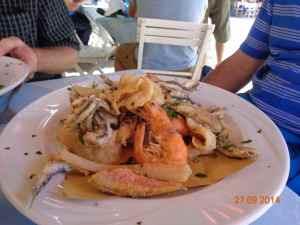
I have no idea what Bob ordered, or what it actually was, but he loved it. Here are the before and after shots. I stuck with the ravioli alla scampi, which I thought would be pretty safe. And it was, except the shrimp were whole– as in heads, antennae, claws, everything. I’ve pulled a lobster apart before, but a shrimp is tiny by comparison (even though these shrimp were probably 6 to 8 inches long). I’m afraid all I attempted was the tail.
More of the sunbathers on the rocks.
Some of the streets of Vernazzo.
This cracked me up. These two ladies were enjoying a glass of wine outside the clothing store. Every few minutes, their friend came out in a new outfit and they happy analyzed it for her. What a way to shop.
The steps up to someone’s front door.
Here we are back in Corniglia. This is the smallest of the villages with only about 250 permanent inhabitants.
Up the little street you saw above is this tiny square. You can see how these pictures fit together if you look at the church in the background.
A look at another front door. It was a few steps down from the main street, which you can see in the picture below.
It was narrow and charming.
Another front door. They were really charming.
At the end of the road we found this terrace with wonderful views. Here’s a view off to the left, back towards the first village we visited.
Here’s a look straight down. Again, the beautiful blue water.
This is the view off to the right, towards the second village we visited.
We all thought this doorway would make a good spot for prom or wedding photos. The little passage under the stairs is the continuation of the road.
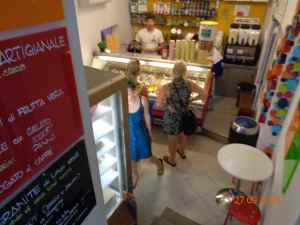
Gelato! We had to step down several steps inside the shop. It was good, but not as good as the stuff we found in Florence. By the way, I had no idea the English and Italian words for the City of Florence were so different. English: Florence. Italian: Firenze.
The final village we visited was Riomaggiore. It was, by far, the steepest of the villages. We parked at the top and walked all the way down, then heaved ourselves all the way back up. You can see a little of the slope in the first photo.
The last photo is my favorite. You can see the dog on the beach. As we stood there admiring the view, he ran down the dock beside us, scampered down the stairs, and frolicked on the beach. He had clearly done this before. He was dancing in the waves, barking, having a really great time . . . until his owner showed up. She was ticked! Apparently he had slipped his leash and she had to chase him all the way down. He didn’t give up easily, she had to literally muscle him out to of the water and drag him up the stairs. Both were drenched, of course. The joys of dog ownership!! I still miss Mel. : )
A couple of shots in the dock area.
Yummy, looks a lot like Bob’s lunch. I’m sorry the photo quality I had to use isn’t good enough to see the little fish eyes looking at you, but they’re there!
Okay, now for the nitty-gritty. Sanitation is an interesting subject in these very old little villages. Why they don’t choose to install real toilets, I’ll never know. It couldn’t be that hard! But no, they apparently prefer something called a “Turkish toilet” which is really nothing more than a whole in the floor. I walked in, saw the deal, and decided I could hold it. The poor ladies from Michigan made another choice, however. Thankfully they were all wearing thongs (on their feet!) so the misfires were easily cleaned up!
I talked to Abby about it last night and she said they’re common in Spain, too. I asked her how to use it properly because the likelihood of disaster seems high. Rather than getting into the details, she sent me to youtube. If you’re curious, here’s one of the videos I found and I agree with all the advice, even though the video refers to conditions in Asia, not Europe. Another word of advice, this is one time where wearing a skirt has a big advantage.
http://www.youtube.com/watch?v=d7KBbjtan9Q
This is a view of La Spezia. It isn’t one of the Cinque Terre villages, but it is the city they’re linked to via the new road that was built in the 1950s. La Spezia is a ship building port and was almost completely destroyed in WWII, so most of the buildings are much more modern than in the rest of Italy.
Curious what Italians grab when they want a snack? Here’s a display we found at the rest stop on the way home.
Once we got back to Florence, we were beyond exhausted. We found a little pizzeria near our hotel and I tried the local specialty: bread soup. It was really, really good. I can see why it’s popular, especially in the winter. It’s thick, hearty, hot and savory. Perfect comfort food.
While we were eating, another couple were seated at the table next to us and we discovered they are from Calgary. After a little more chatting, we found she was another recovering attorney who’d turned to writing anything other than legal documents for a living. She’s even published a romance novel and is a member of RWA. I felt like I’d met a long lost sorority sister! We’re hoping to catch up at next year’s national convention : )
Florence!
Florence is both ordinary and absolutely fantastic. At first glance, it is a little dull, a little dingy, and everywhere we looked things are surrounded by plastic sheeting and scaffolds. However, look a little deeper and the real gem is revealed. Many of the buildings are medieval, built in the 9th, 10th and 11th centuries. These buildings are simple, but if you look closely, there are details worth noting. For example, look at the original palace built by the Medici Family in the mid-1100’s.
 I know, it doesn’t look like much, but look again. Start at the base of the building where you can see between the cars. There is a bench built into the building along its entire length. Believe me, as a tourist today, I really appreciate such thoughtfulness! It’s hard to see in this photo, but above the benches are rings where horses could be tied and on top of these are brackets for torches so the walk would be well lit. The architecture of this building may seem commonplace, but that’s because its been copied all over the world. When this building was made, it was very unique. Even the scrolling under the eves were seen for the first time in this building. Also, notice the brackets in the wall between the windows. Two of them are being used to hold the flags over the door. Can you imagine flags in all the holders? It would be quite festive.
I know, it doesn’t look like much, but look again. Start at the base of the building where you can see between the cars. There is a bench built into the building along its entire length. Believe me, as a tourist today, I really appreciate such thoughtfulness! It’s hard to see in this photo, but above the benches are rings where horses could be tied and on top of these are brackets for torches so the walk would be well lit. The architecture of this building may seem commonplace, but that’s because its been copied all over the world. When this building was made, it was very unique. Even the scrolling under the eves were seen for the first time in this building. Also, notice the brackets in the wall between the windows. Two of them are being used to hold the flags over the door. Can you imagine flags in all the holders? It would be quite festive.
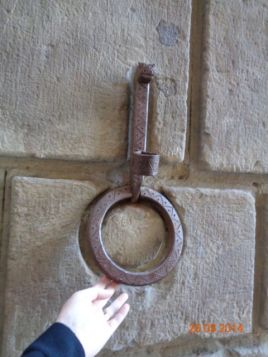 Here’s a close-up of the ring used to tie up horses and you can see the bracket where they stuck the torches. Notice the very top of the bracket has a little animal head. Of course, there are some buildings that are so breathtaking on the outside, it’s hard to leave the street and enter them. One of those buildings is the Duomo, also known as the Basilica di Santa Maria del Fiore, or Saint Mary of the Flowers.
Here’s a close-up of the ring used to tie up horses and you can see the bracket where they stuck the torches. Notice the very top of the bracket has a little animal head. Of course, there are some buildings that are so breathtaking on the outside, it’s hard to leave the street and enter them. One of those buildings is the Duomo, also known as the Basilica di Santa Maria del Fiore, or Saint Mary of the Flowers.
 See what I mean? This building is completely covered in marble. Mostly white, green, and pink marble. The building was begun in the 1200’s but wasn’t completely finished until the 1800’s. The detail is so intricate, I could have spent hours just looking at it. Surprisingly, the inside isn’t at all what I expected. I thought we’d be overwhelmed with bric-a-brac and elaborate details, but that isn’t the case. The inside is huge, and its covered in an elaborate and varied marble floor.
See what I mean? This building is completely covered in marble. Mostly white, green, and pink marble. The building was begun in the 1200’s but wasn’t completely finished until the 1800’s. The detail is so intricate, I could have spent hours just looking at it. Surprisingly, the inside isn’t at all what I expected. I thought we’d be overwhelmed with bric-a-brac and elaborate details, but that isn’t the case. The inside is huge, and its covered in an elaborate and varied marble floor.
 See how it’s pieced to produce an optical illusion? This is just a small section; it varies in design and complexity every 20 feet, or so.
See how it’s pieced to produce an optical illusion? This is just a small section; it varies in design and complexity every 20 feet, or so.
The walls have paintings and stained glass windows and the altar is beautiful, but not as elaborate as others we’ve seen. 
The real show is the dome. You can see the light from it above the altar, but until you get under it, you can’t know how amazing it is. Of course, the pictures can’t begin to do it justice. 
To give you an idea of how large this dome is, the wood rim beneath the smaller round windows is actually a walkway, and so is the rim above the windows and just below the frescoes. Also, the sunlit spot at the top is called the lantern, and it is also full of people. It costs 10 Euro for a ticket to climb into the dome, and it’s hundreds of claustrophobic steps, but we plan to do it in the next couple of days. The dome is a bit of an engineering mystery/miracle. It’s way too complicated for me to explain, or even completely understand, but you can read more here.
http://en.wikipedia.org/wiki/Florence_Cathedral
The rest of the city we’ve seen so far is in the photos below. It’s just a taste, but we have all week to soak it up!
Cracked me up. Have a reservation at this hotel? Too bad, so sad. No idea where you’re supposed to go.
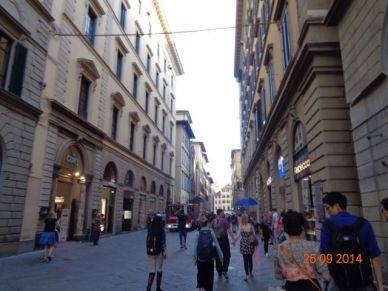 A typical medieval street in Florence. The cars, motorbikes and buses sometimes go down them, but the side streets are mostly for pedestrians. Mostly. You still have to watch out.
A typical medieval street in Florence. The cars, motorbikes and buses sometimes go down them, but the side streets are mostly for pedestrians. Mostly. You still have to watch out. 
Bob and dinner last night. I had to laugh because a couple sat at the table next to us and she was clearly having trouble with her leg. Bob, always the doctor, asked her about it. The couple was from Norway and she was having lots of pain. One thing led to another and before I knew it, Bob was palpating her leg muscles and looking for pulses. The lady was worried about a blood clot, but Bob was able to reassure her that a blod clot was unlikely. She was very grateful and they were fun to talk to.
 This is the tower of the Palazzo Vecchio, the building beside the restaurant. I was amazed by the staircase so far up there — that doesn’t appear to have a handrail!
This is the tower of the Palazzo Vecchio, the building beside the restaurant. I was amazed by the staircase so far up there — that doesn’t appear to have a handrail!
 Bob had the lasagna and it was AMAZING!
Bob had the lasagna and it was AMAZING! 
Here’s a full picture of the Palazzo Vecchio, with that tower way up there. 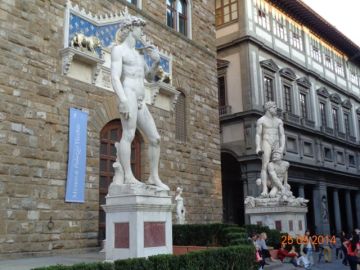
The front of the Palazzo Vecchio, which is currently the city government building in Florence. Notice the statue of David? Its a copy, but its in the place where the original David stood for centuries before it was moved to the art school (I think in the 1700’s).
 Ever seen a real live Stradivarius violin or cello? How about both? Here you go, the nearer one is a violin and the further one is the cello. They really are properly sized for those instruments, the angle of this shot makes that hard to see. These are originals and the violin has never been restored. It is exactly as it was when Stradivarius made it so it’s priceless today. Every year both of these instruments are taken out of the case and played by some very lucky musicians.
Ever seen a real live Stradivarius violin or cello? How about both? Here you go, the nearer one is a violin and the further one is the cello. They really are properly sized for those instruments, the angle of this shot makes that hard to see. These are originals and the violin has never been restored. It is exactly as it was when Stradivarius made it so it’s priceless today. Every year both of these instruments are taken out of the case and played by some very lucky musicians.
So, here we go. This is the original David. Call me stupid, but I never really understood that the statue depicted David right before he killed the Philistine giant, Goliath. It was originally built to decorate a church, but because the statue shows the moment where David is considering Goliath and making his plan of how to act, the Florentines of the time felt it depicted mind over brawn, which was much more of a political statement that resonated with them at the time. So, the statue was placed in front of the Palazzo Vecchio, the center of their government.
The detail is incredible and the proportions are perfect, except for the head and hands, which are a little big. Since Michelangelo made the statue for a church where it would be seen from a distance, it is thought he made the hands and head bigger to emphasize the mind over brawn theme.
This is the front and back of a plaster statue made by one of the teachers at the school or art. The plaster was made to get the details right before it was carved out of marble. I liked it because of the children.
This is a clock in the back of the Duomo. It dates to the middle ages so it’s not a conventional clock. First, it runs counter-clockwise. Next, it has all the hours of a day. Finally, 1 o’clock always depicts the hour the sun sets. It still works, but it needs to be readjusted every couple of weeks. Above, the clock shows its about 9 hours until sunset, which was correct at the time.
This is a view of the dome from the outside. You can see the large circular windows that were obvious from the inside. Above them is the dome, which is actually two domes in one. The one here is the outer dome and the one with the pained frescoes on the inside is a separate dome.
This is three shots of the same market. It is said if you touch the pig’s snout, you’ll return to Florence someday.
These are views from the same spot. The top picture is the left of the camera and the bottom picture is to the right. Of course, the bottom picture is of the Ponte Vecchio, the oldest bridge in Florence, and the only one left standing by the Germans in WWII. Originally, the shops on the Ponte Vecchio were all butchers because they dumped the “extras” from the carcasses into the river–thus cutting down the smell. Nowadays, its the center for gold and silver in Florence.
A view down the Ponte Vecchio. Every store window was literally dripping with gold jewelry of all kinds.
Here, a shop lady has to use tongs to reach one of the hundreds (thousands?) of items in the window. When she got it, Bob applauded and she bowed to him and laughed.
Did I mention that some of the styles in the shops are kinda questionable? Here’s a good example of something not everyone can carry off. Maybe only a basketball sportscaster?
Gelato was invented in Florence. O.M.G. It was heavenly. I don’t have words. I barely had breath to breathe. It was fabulous!
Final note for today: Doing laundry at a laundromat in a foreign county is SO much more enjoyable if you’re just a little bit tipsy. Just saying. : )
Capri
Yikes, I’m a little behind. I blame it on the wine. By the time I’ve had a glass, I’m not much up for sorting photos and writing a blog. So, sorry for the delay!
On Sept. 24th, we went to Capri for the day. We caught a taxi to the port . . . and it finally happened; we were in a car accident. It was supper minor, the two cars just scraped their rear ends together as they passed, but it sure ticked off the cab driver! It happened in a spot where the road (only about 10 feet wide) made a hairpin turn — and I mean a sharp U. Even little cars, if they don’t approach just right, will have to back up to properly complete the turn. Did I also mention the road is two-way and only one car can pass through the bend at a time? In our case, the taxi passed through the U but the oncoming car didn’t wait for us to clear and he wedged himself into the U and started to turn which made the back bumpers of the two cars scrape together. Given crazy Italian traffic, I’m surprised it hasn’t happened sooner.
Anyway, our trip to Capri was a little shaky because it was pouring rain. It wasn’t a big deal on the boat, but it was a different story on the bus we boarded to take us from the port to Anacapri. Unfortunately, the bus had many holes — the skylights, the windows, the door, everything leaked. It was bad that our tour guide, who was standing in the stairwell by the door, had water up to his ankles! By the time we got to Anacapri, no one was dry. Another thing, the busses are designed to move as many people as possible as quickly as possible. They literally have 7 inches between the seats. Everyone had to sit with their knees slanted into the minuscule aisle, or up by their ears. I’m not even sure children would fit well on that bus. It’s a good thing we were with a cheery group! Luckily, by the time we were ready to explore Anacapri the rain stopped and the rest of the day was sunny and beautiful.
When I think of Capri, I think “beautiful island” and “shopping.” Well, both are true. However, the shopping wasn’t very interesting because most of the shops are also common in the States. I checked a couple of places and found the prices weren’t very different, either. So, we stuck to wandering around and enjoying the views. We definitely can’t get those at home!
While doing this, we met some really interesting people. Actually, we’ve met many people on this trip so far. Most have been from London or Boston — probably because Bob wears his BU hat everywhere so people stop him on the street to ask if he’s from Boston. The Capri trip was no different. For some reason, it is often the case that the people we meet have kids around Abby’s age. I’ve really enjoyed hearing people from all over talk about their everyday lives and finding they are absolutely no different than our experiences in the US. People are people no matter their religion or nationality. Of course, I knew this, but it is an absolute delight to see the evidence first hand. My favorite example is the couple we met from Glasgow. They left their 16 year old son home for the weekend and they were absolutely gleeful about the fact they arranged for grandma to stay with him, sort of against his will. They had lots of stories of wild parties and stupid teenage behavior, all to familiar to parents the world over.
So, back to Capri. It’s a small island with rugged shorelines, amazingly blue waters, a couple of old towns (Anacapri and Capri Town), and lots of history. It’s not easy to get around; the roads are very narrow and they climb steeply up the craggy slopes of the island. You can walk around quite a bit of it, but that involves literally hundreds of stairs, so wear comfortable shoes!
Here are some pictures to help you imagine. : )
Okay, I’m starting with breakfast. Have I told you about the breakfasts we’ve had on this trip so far? All of our hotels have breakfast included and the one in Sorrento was exceptional. It started with fresh-squeezed orange juice (sometimes complete with a seed or two), then fruit, a small Caprese salad, and a selection of cheeses and smoked/cured meets. After that is a frittata or omelet of the day and a beautiful selection of pastries. We had to leave early for the trip to Capri so we only had 10 minutes to eat. I grabbed the pastries and brought them with us to enjoy in leisure. They were still warm and absolutely divine.
Finally, a view of Capri from Anacapri. The land in the distance is the Sorrento peninsula, with Sorrento on the left side and the beginning of the Amalfi Coast on the right.
Some views of what the cities are like. Like the Amalfi Coast, they are built on a steep hillside, so stairs and steeply sloping walkways are the best way to get around. It was also very crowded in places.
At first, I thought this might be a new-fangled Italian fashion (some of them are really weird!) but then I realized it was an art gallery. : )
We found lots of beautiful spots walking around the shopping districts.
These photos were taken from the Gardens of Caesar Augustus. The shoreline was breathtaking, but the path leading to the next little village along the coast was also spectacular. The village is just around the first cliff and tucked into the cove. In these pictures, you can see how the curve in the road in the first picture is the same as the one in the second picture. Together, they fit together to give you a picture of the whole coastline.
This is more of the same shoreline as the pictures above, but it shows more detail. If you look closely, you will see a little hut, a stairway hewed out of the rocks, and the roof of a small round structure. Can you see the two structures and the stairs in the first picture? If not, I zoomed in for you.
Another view from Caesar’s Garden. Once the rain stopped, it was a beautiful day!
I got a kick out of this necklace. I also love jellyfish, so it was tempting. : )
This is an ad on the back of the bus, but these watches, known as Capri watches, were everywhere in the stores. They’re kind of whimsical.
Another view of the marketplace. Just lovely.
Hot dog and apple pie: American dinner, Italian style.











